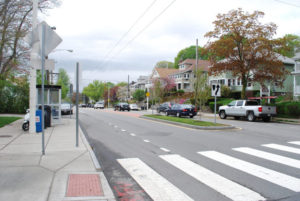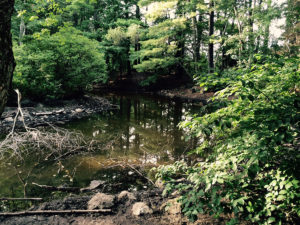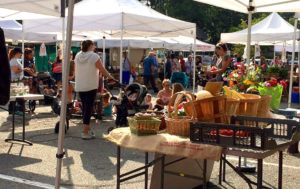By Tammy Calise
Where we live shapes our behaviors and influences our physical and mental health. While everyone deserves to live in a neighborhood that supports healthy lifestyles, it is especially important for youth and older adults—and compared to the state overall, Belmont has a higher percentage of the population under 18 years (21 percent vs. 24 percent) and over 65 years (15 percent vs. 24 percent).
The University of Virginia’s Center for Design and Health and Hart Howerton, an interdisciplinary design firm, endorse nine principles that ensure the design of our neighborhoods promote health: smart locations, integrated nature, mixed land use, variety of housing, pedestrian-oriented streets, pride of place, access to healthy food, lifelong learning, and sustainable development. So how is Belmont doing?
1. Smart locations
In communities where residents can meet basic needs without using a car, they live within walking distance of the services they need and use frequently—grocery stores, parks, schools, libraries—and can walk or bike safely. There is also easy access to public transit. Getting around without cars reduces the amount of land needed for roads and parking, helping to preserve land for other uses, including wildlife habitats. Residents in these areas also tend to spend more money locally.
Belmont has three primary centers—Belmont Center, Cushing Square, and Waverley Square—where residents can shop, dine, go to the library or a park, and catch the commuter rail or a bus to neighboring cities and towns. A bus route connecting these centers could help more people to stay in town, reduce traffic, and encourage exercise via walking to bus stops. Such a bus could also let high school students and visitors get to the school without using a car.
2. Integrated nature
Connected trail networks and green spaces help maintain and cleanse the environment by removing harmful toxins from the air and water. They promote physical activity and mental health.
Belmont has a number of natural resources and green spaces including the Mass Audubon’s Habitat Education Center and Wildlife Sanctuary, Beaver Brook State Reservation, and Rock Meadow Conservation Land. Development of the Community Path would connect neighborhoods in Belmont and provide residents a safe, off-road path to walk, bike, stroller, and skate along an ever-expanding trail network.
3. Mixed land use
Combining housing, schools, shops, and places of worship in a compact area provides easy access to services and decreases reliance on cars. Community centers also provide opportunities for neighborhood interactions that create a sense of familiarity and predictability that most people find comforting.
Though Belmont has not officially changed its primary zoning to mixed use, land use is effectively mixed near town centers. Residents of these areas can more easily access the shops, restaurants, and parks compared to other neighborhoods. Maintaining and enhancing the streets, including sidewalks, bike lanes, and bus routes, would enhance Belmont residents’ health.
4. Variety of housing
Communities with a mix of housing types (e.g., apartment buildings, small homes, and larger homes) create attainable housing for all community members of all backgrounds and ages.These communities naturally encourage economic and demographic diversity.
The development of the Bradford (formerly known as Cushing Village) will include approximately 38,000 square feet of commercial space on the ground floor and 115 apartments on the floors above, including 12 affordable housing units.The one- and two-bedroom units may include young professionals who want to live within easy access to Boston and older Belmontians who wish to downsize and live within walking distance to public transportation, shops, and restaurants.

Trapelo Road at the corner of Williston Road in Cushing Square has a center divide, clear bike lane markings, enlarged crosswalk, newly paved and expanded sidewalk, and a covered bus stop. Photo by John DiCocco
5. Pedestrian-oriented streets
A pedestrian-oriented street is welcoming, safe, and accessible for people in all forms of transportation but especially on foot. Designing the street with pedestrians in mind—improved lighting, continuous well-maintained sidewalks, raised medians, better bus-stop placement, and traffic-calming measures—improves pedestrian, bicyclist, and motorist safety.
The enhancements on Trapelo Road, including medians, sidewalks, have created a more pedestrian-friendly street. Unfortunately, the abutting residential streets continue to enable drivers to speed. Belmont is now ensuring that repaved roads have sidewalks. Additional actions to create pedestrian-friendly streets include installing pinch points, street markings, more trees (which make the street look narrower), and cues to slow drivers (e.g., texture, speed humps, cushions).
6. Pride of place
Communities with a variety of linked gathering places enable residents to be physically active, meet, and mix.They encourage social interaction in parks and appealing shopping areas and allow festivals, fairs, and town days.
Belmont supports social interaction through its many wonderful parks including the recently renovated Pequosette Park, Joey’s Park, and Town Field.In nice weather, these places are ideal for friends and families. All Belmont’s parks need adequate trash containers (with regular collections) and accessible portable toilets to support the healthy use of these spaces. There is no pride in park closures due to rat infestations.
7. Access to healthy foods
Encouraging backyard and community gardens, farmers’ markets, food co-ops, and grocery stores with a wide range of fresh vegetables and fruits supports healthy diets.
Belmont has a number of sources of healthy food. The Belmont Victory Gardens are one of the largest and oldest active community gardens in the Boston area, covering two acres with 137 plots. The Belmont Farmers Market in Belmont Center matches government benefits to help all families access healthy, local food: SNAP (Food Stamps), WIC (for moms & babies) and FMNP (for seniors), and HIP (a SNAP incentive program). A neighborhood grocery store in Cushing Square would further increase access to healthy foods.
8. Lifelong learning
Communities should help residents share their skills, knowledge, and experience with others. Schools should be part of an active transportation network so walking and biking are practical options.
Belmont has traditionally supported neighborhood schools. Unfortunately, more and more Belmont students are in schools outside of their neighborhood. They do not walk or bike to school and do not get the health and social benefit of that physical activity.
As much as 20 to 30 percent of morning traffic is generated by parents driving their children to schools. While busing is a safer way to get to school than in a private vehicle, the average cost for bus transportation across the United States is $932 per student. In Belmont, the family bears some of this cost. Students in grades 7-12 must pay $575 per student to take the bus regardless of distance, and any child (K-6) living less than two miles away from the school must also pay the fee.
9. Sustainable development
Low-impact development and green building technologies benefit human health and the environment. In Belmont, Sustainable Belmont’s initiatives have included an anti-idling campaign to improve air quality and reduce gas consumption and supporting energy service company projects to improve energy efficiency in town buildings.
A greater dedication to healthy neighborhood principles will help Belmont support residents’ physical and mental health.
Tammy Calise, DrPH, is a Belmont resident and mother of two. She is a public health professional with over 21 years of experience at the local, state, and federal levels to create healthier communities.




Sorry, the comment form is closed at this time.